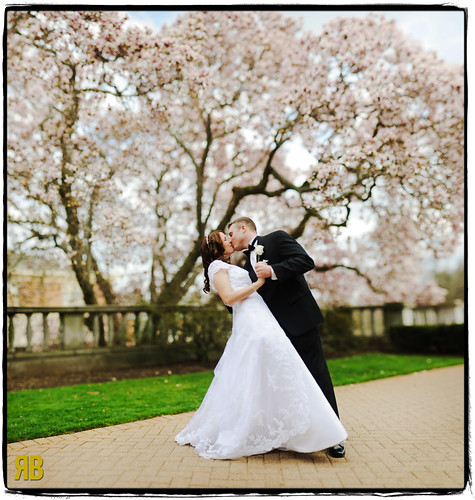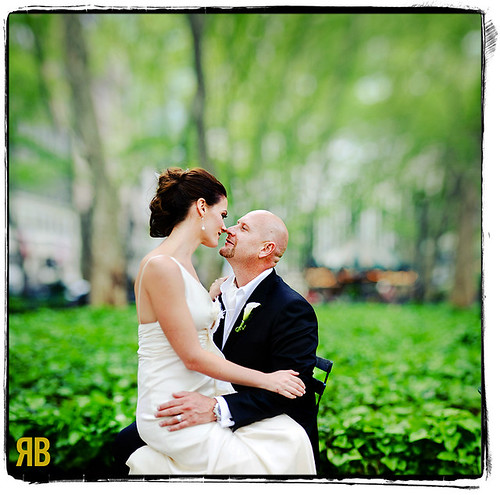|
Saw this last night:quote:Stitch Yourself a Thinner Depth-of-Field http://www.amazon.com/gp/blog/post/PLNK1JWPN65CVOSZV I've been following this guy's work for some time now, and he's a pretty good wedding photographer. Anyway, the technique he outlines above is interesting, but I'm not sure I fully get it. I think what he's trying to say is that by opening up your aperture as wide as you can and turning a regular shot into a panorama, you simulate the effects of a larger sensor because the image becomes larger but the depth remains the same... Is that right? Here are two more he put together using this same technique:   What do you guys think of this?
|
|
|
|

|
| # ¿ May 4, 2024 20:31 |
|
In one of the comments somebody asks about this and he explained they have to hold still for a minute. Even though they move a little bit it's "close enough" for Photoshop to match everything up. My question, though, is whether or not I actually understand the technique to begin with. He doesn't really explain it very well in his article, and I just sort-of interpreted it. But I am curious about it, so I'll reach out to him and see if he responds.
|
|
|
|
Well, using a 4x5 is a pain, and how many 4x5 setups are digital and affordable at the same time? I really don't know to be honest, but at least with digital you can get the results pretty quickly. As far as faking it in Photoshop, I think it's hard to fake shallow depth in Photoshop without a lot of work. I found a better write-up of this technique here and the photographer giving a video overview of how it works on facebook, here. (Here is a video of him doing it on flickr). From the video, you can see it only takes 10-20 seconds to acquire the shots needed for the panorama, and it probably takes 10-30 minutes of photoshop work later? Eh.. it's an interesting idea I guess, which might be useful for certain key shots that are important.
|
|
|
|
I think that increases the dof, not decrease it.
|
|
|
|
AIIAZNSK8ER posted:I assume that it blows up to a 8x12 nicely. I think he crops everything to 8x10 or 4x5.
|
|
|
|
brad industry posted:I always scout locations beforehand and have at least 1 or 2 solid ideas (like sketched out and know exactly how I want it lit) I don't think any photographers here sketch out their ideas on paper ahead of time -- for better or worse. I wonder if most professionals do either. Edit: yeah, I don't know what I'm talking about, ignore this statement. Mannequin fucked around with this message at 05:58 on Oct 2, 2009 |
|
|
|
Spectracide posted:I used to think ISO 100 was the "best" ISO. Now, it seems most high-end cameras start at 200. Can someone explain this to me? I am thinking it has something to do with the switch from CCD to CMOS sensors. My best guess is that they do this so that they can get cleaner pictures at the high end. If they start at a faster ISO they can end at a faster ISO. If ISO 100 was the base, then 3200 would be the max. Instead, 6400 is the max (and then you can push it to 12,800 or 25,600). To answer your other question, no, a sensor that starts at 200 is not worse than one that starts at 100. They're just different. You have to look at the other characteristics of the sensor to determine if one is better than the other. Where the 200/100 thing becomes a problem is when you take a camera whose native ISO is 200 and lower it to 100, because the camera has to perform additional functions to get that to work and it can affect image quality.
|
|
|
|
InternetJunky posted:I feel like I'm beating a dead horse here, but for the sake of my sanity please check this larger version of the uncropped original and tell me if you can't see what I'm talking about regarding the visible red areas on the bird's head (under the eye) and on the tail. Both areas are big enough in the original that they're not being identified as purely noise by the noise reduction algorithms. I can see the red/magenta dots on both the cropped and uncropped versions. EXIF on the image you linked to reads ISO 280. Are you sure you were shooting at 3200? It looks like it, because of the noise factor, but I want to make sure you're not actually shooting at a lower ISO and it's still producing that noise. If you were at 3200, that's not bad at all!
|
|
|
|
I would be interested in learning more about workshops in general, but I don't think I would ever shell out a lot of cash to attend one. I was planning on attending a free event next Sunday to hear Peter Turnley speak, but I've realized it's Mother's Day and may have to skip it.
|
|
|
|
I would pick up a Sony NEX if it was about 50% less than what they want for it. Otherwise, it's a bit too steep for me. Looks cool, though.
|
|
|
|
bazaar apparatus posted:I really wish Eye-Fi would come out with a CF card that will fit into my 20d The CF card adapters work but there are problems with transfer times. Most cameras that require CF cards produce images that are 15+ mb and transferring those wirelessly can take a long time.
|
|
|
|
I'm 97% sure I'm going into New York tomorrow. Want to catch an early-ish train and be there by 10:00 a.m. Not sure what I'm going to photograph. I am really nervous about it. Here's hoping I don't waste a whole day, waste $30 bucks or so, kill my feet, and ultimately feel completely disappointed in myself... again.
|
|
|
|
I've got a question about this photo: Click here for the full 1404x993 image. It's a neat concept but something troubles me about it. To get the proper exposure for the motorcycle you have to assume the shutter is open for several seconds at least, to travel from one end of the frame to the other. (It's quite a distance). Let's say it would take the motorcyclist a minimum of 5 seconds if he were moving fast to go the full distance in the frame. But in this time, the cars on the left side of the highway would have to be moving since there is a pretty good amount of space in between them. No one would sit that far apart from each other and keep still enough for the frame to be mostly blur-free for so long. At least it seems unlikely. So, I guess that would mean the photo is faked, or at least composited or something. What do you think?
|
|
|
|
brad industry posted:Look at the truck he passes in front of, you can't see the light through the windshield (and you can see other taillights shining through windshields all over the place). Wow, good observation. Yeah, I guess a composite makes sense. Maybe they took 4 or 5 shots of the bike weaving through traffic but just one overall shot of the cars.
|
|
|
|
FetusOvaries posted:So is in-camera sharpening a dumb thing to use? If you shoot RAW it has no effect, just a heads-up. Actually, it kind-of depends. If you shoot Nikon and use CaptureNX, then in-camera sharpening will be visible in the RAW file but you can turn it off in the software. Not sure about Canon. Those in-camera settings really only affect JPEGs and TIFFs, and how it might look on the back of your LCD. But that's it. Augmented Dickey posted:what the hell is going on with the bottom right corner of this image? Holy hell, I totally missed that. Wow, that's pretty bad.
|
|
|
|
Ah gently caress, I just came back from shooting some film and realized I underexposed some shots of a white wall. I was using Auto/Aperture Priority on my FE2 and set exposure to -1/3 EV because I thought it would overexpose the white wall not underexpose. D'oh! Now it's going to be even worse.
|
|
|
|
8th-samurai posted:It will probably be okay as long as you were shooting negs. A third of a stop is nothing to film unless you were running slide film. But I was shooting a white wall w/center metering so I'm thinking it underexposed it anyway. Oh well.
|
|
|
|
brad industry posted:Third of a stop wouldn't have been enough anyways. Meter averages to middle gray so to get a white wall white you need to overexpose what your meter says by 2-4 whole stops depending on what value of white you want. Yeah, actually, just started reading about it. It looks interesting. Took me long enough...
|
|
|
|
Cross_ posted:So what zone would it fall into? VII for the wall and V for an expected 20% gray reference ? The wall would have been a VII and the camera would have set a shutter speed to bring it down to V. One shift in zone = 2 stops, so it would have gone down two zones or 4 stops. My 1/3 increment wouldn't have made enough difference even if I had flicked it in the correct direction. Edit: Since it was a white wall getting a decent amount of light it might have even been at a VIII, so it's really going to be underexposed. Mannequin fucked around with this message at 05:54 on Nov 16, 2010 |
|
|
|
Kiri koli posted:I'm in the middle of acquiring a 50mm f1.8 from craigslist and the guy said that he has a UV filter on it. On the advice of everyone here I'll be removing the filter, but since I'll have it anyway, are there any situations were it might come in handy? I'm sure it's cheap as hell. Shooting in dusty/sandy conditions, or if you are near sea water. Worst time to use it would be at night.
|
|
|
|

|
| # ¿ May 4, 2024 20:31 |
|
Been a while since I posted here. Had a question regarding portfolio sites and this is something I've always struggled with: is it better to post the work other people think is your best, the work you think is your best, or a mix of both? I'm doing a mix of both. But some of the pictures that people are really drawn to (based on flickr stats at least) I feel are somewhat iffy, and some of the pictures I personally love get almost no attention.
|
|
|






